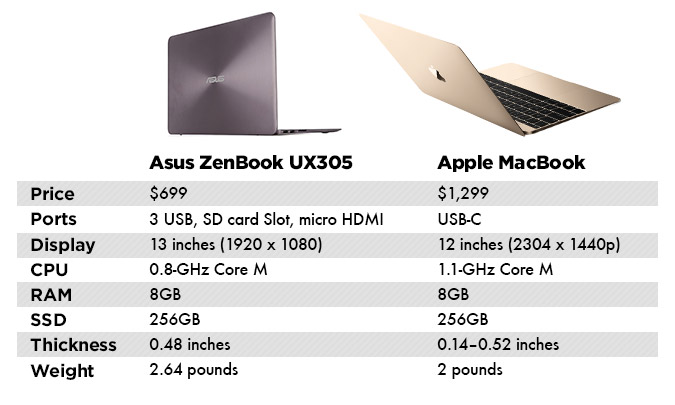Best New MacBook Alternative Is $600 Cheaper

Every time Apple unveils a new laptop, its competitors attempt to ride the ensuing PR and social media tsunami by making direct comparisons to their own products. Two days after the new 12-inch MacBook with Retina display ($1,299) launched, Asus took to Twitter to tear it down, highlighting that its $699 ZenBook UX305 is even thinner (12.3 mm versus the new MacBook's 13.1 mm). As it turns out, that's the least compelling reason to consider this machine over Apple's.
Here's why the UX305 is the best alternative to the new MacBook for your money.
1. It's $600 cheaper and has similar specs.
Core M processor: Check. 8GB of RAM: Check. 256GB SSD: Check. While the clock speed on the $699 Asus UX305 is lower (0.8 GHz versus 1.1 GHz), you're getting comparable specs and storage for $600 less than the $1,299 12-inch MacBook. In fact, the UX305 is one of the best laptop deals of the year, as you never see this size SSD at that price. (As of this writing, the Microsoft Store is selling the UX305 for $699, but Amazon is overcharging with its $819 price.)
MORE: Best Ultrabooks Available Now
2. More ports
Apple made the extreme decision to include only a headphone jack and a single USB-C port on the 12-inch MacBook. USB-C can deliver power to the laptop, as well as feed video to external displays and power gadgets (with the right dongles). But Asus doesn't force you to carry extra adapters. The UX305 sports three USB 3.0 ports, an SD card reader and a micro HDMI port, in addition to the combo headphone/mic jack. No compromises required.
3. Long battery life
The new MacBook uses a new terraced battery design that gives Apple's 2-pound wonder a rated 9 hours of wireless Web browsing on a charge. That's great, but the Asus UX305 lasted a strong 9 hours and 38 minutes on the Laptop Mag Battery Test, which involves continuous Web surfing over Wi-Fi.
MORE: Best & Worst Laptop Brands
4. More traditional keyboard and touchpad
In order to make the 12-inch MacBook so compact and thin, Apple decided to switch from a traditional scissor switch for each key to a new butterfly mechanism. The result is a keyboard that's plenty large but whose keys feel flatter than those on the Asus.
However, the UX305 doesn't have a keyboard backlight — one of the concessions Asus made to keep the cost down. It's also worth noting that the new MacBook's touchpad doesn't physically depress like the UX305. Instead, Apple's Force Touch trackpad uses a "taptic" engine to deliver the sensation of a click. I prefer the feel of Asus' pad, but it's a lot louder than Apple's.
MORE: New MacBook Is Too Ahead of Its Time
What the MacBook Does Better
The new MacBook has a number of advantages over the Asus UX305, starting with its lighter design. The difference between 2 pounds and 2.6 pounds doesn't seem like much, but it's noticeable. In addition, the MacBook has a backlit keyboard, and the Asus doesn't. The MacBook also benefits from a sharper Retina display (2304 x 1440p vs. the Asus' 1920 x 1080p) that's richer and more colorful. However, some users may prefer the matte finish on the Asus, which reduces glare. An upcoming $999 model of the UX305 will offer a sharper glossy QHD display (3200 x 1800p) with touch capability.
Last but not least, Apple's ultraportable has more personality, coming in three colors: silver, space gray and gold.
Bottom Line
The Asus ZenBook UX305 isn't the only excellent alternative to the 12-inch MacBook. The Dell XPS 13 (starting at $799) crams a bigger, 13-inch display into a chassis the size of an 11-inch MacBook Air. And the new HP Spectre x360 ($899) has a touch display that flips all the way around, so you can use it in tablet mode. But Asus' Ultrabook stands out because of just how much you get for the money versus Apple's ultrapremium machine.
Stay in the know with Laptop Mag
Get our in-depth reviews, helpful tips, great deals, and the biggest news stories delivered to your inbox.

